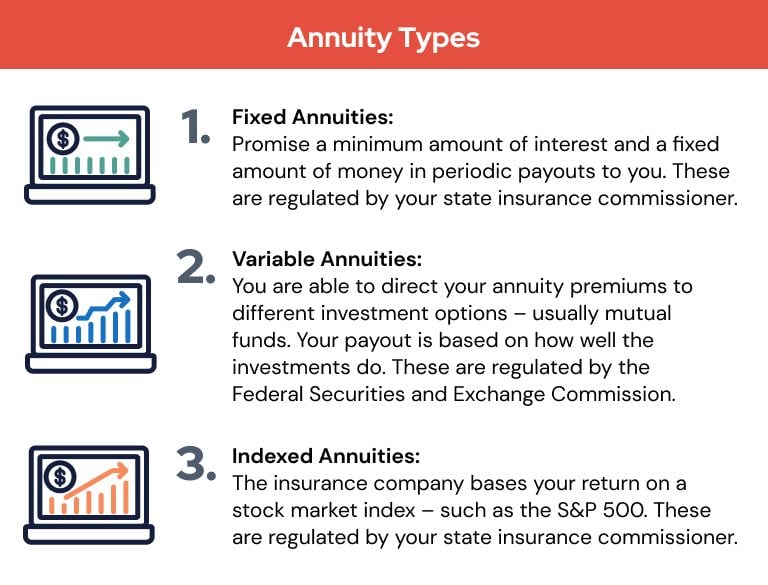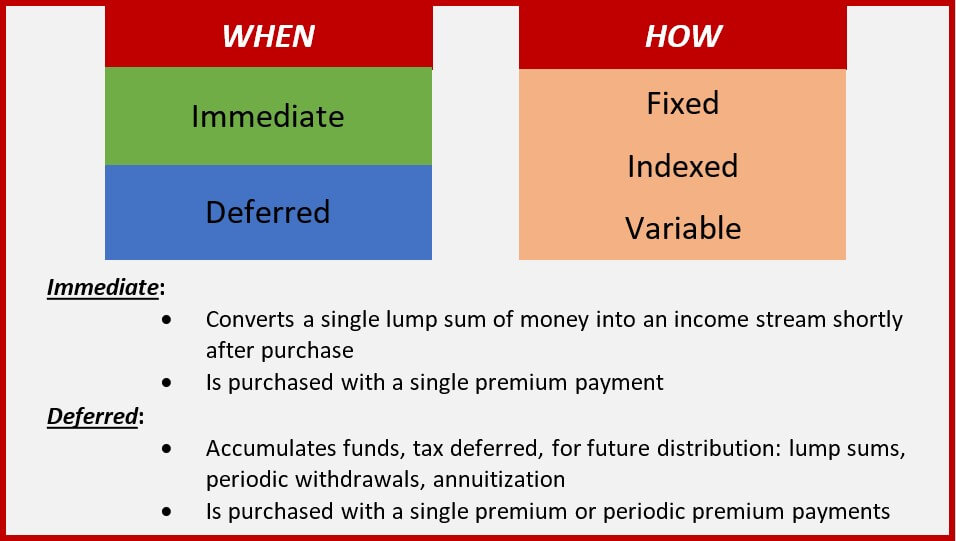All Categories
Featured
Table of Contents
Equally as with a repaired annuity, the owner of a variable annuity pays an insurance provider a lump sum or series of repayments for the promise of a series of future settlements in return. But as mentioned over, while a dealt with annuity grows at a guaranteed, consistent rate, a variable annuity grows at a variable price that relies on the performance of the underlying investments, called sub-accounts.

During the build-up phase, possessions bought variable annuity sub-accounts grow on a tax-deferred basis and are tired just when the contract owner withdraws those revenues from the account. After the accumulation stage comes the income stage. With time, variable annuity properties must in theory raise in worth till the contract proprietor determines she or he want to begin withdrawing cash from the account.
The most substantial issue that variable annuities normally present is high cost. Variable annuities have a number of layers of costs and expenses that can, in accumulation, create a drag of up to 3-4% of the contract's value each year.
Decoding Variable Annuity Vs Fixed Indexed Annuity A Comprehensive Guide to Investment Choices What Is the Best Retirement Option? Advantages and Disadvantages of Indexed Annuity Vs Fixed Annuity Why What Is A Variable Annuity Vs A Fixed Annuity Is a Smart Choice Variable Annuity Vs Fixed Indexed Annuity: Explained in Detail Key Differences Between Variable Annuities Vs Fixed Annuities Understanding the Key Features of Fixed Vs Variable Annuities Who Should Consider Annuities Fixed Vs Variable? Tips for Choosing the Best Investment Strategy FAQs About Fixed Vs Variable Annuities Common Mistakes to Avoid When Choosing a Financial Strategy Financial Planning Simplified: Understanding Your Options A Beginner’s Guide to Fixed Index Annuity Vs Variable Annuity A Closer Look at Fixed Income Annuity Vs Variable Annuity
M&E cost fees are calculated as a percentage of the contract value Annuity issuers pass on recordkeeping and other administrative expenses to the agreement owner. This can be in the kind of a level annual charge or a percentage of the agreement value. Management charges might be consisted of as part of the M&E threat cost or may be analyzed separately.
These charges can vary from 0.1% for easy funds to 1.5% or even more for actively handled funds. Annuity agreements can be personalized in a number of ways to serve the details needs of the contract owner. Some common variable annuity riders consist of guaranteed minimum buildup benefit (GMAB), guaranteed minimum withdrawal benefit (GMWB), and assured minimal revenue benefit (GMIB).

Variable annuity payments provide no such tax obligation deduction. Variable annuities have a tendency to be extremely inefficient automobiles for passing wealth to the future generation since they do not enjoy a cost-basis adjustment when the original agreement owner dies. When the proprietor of a taxed financial investment account dies, the price bases of the investments held in the account are gotten used to show the marketplace rates of those investments at the time of the proprietor's fatality.
Breaking Down Your Investment Choices Key Insights on Immediate Fixed Annuity Vs Variable Annuity What Is the Best Retirement Option? Pros and Cons of Various Financial Options Why Choosing the Right Financial Strategy Is Worth Considering Fixed Interest Annuity Vs Variable Investment Annuity: Simplified Key Differences Between Fixed Income Annuity Vs Variable Annuity Understanding the Key Features of Long-Term Investments Who Should Consider What Is A Variable Annuity Vs A Fixed Annuity? Tips for Choosing Fixed Annuity Vs Variable Annuity FAQs About Fixed Interest Annuity Vs Variable Investment Annuity Common Mistakes to Avoid When Planning Your Retirement Financial Planning Simplified: Understanding Fixed Index Annuity Vs Variable Annuities A Beginner’s Guide to Fixed Interest Annuity Vs Variable Investment Annuity A Closer Look at How to Build a Retirement Plan
Beneficiaries can acquire a taxed financial investment profile with a "clean slate" from a tax obligation perspective. Such is not the situation with variable annuities. Investments held within a variable annuity do not obtain a cost-basis adjustment when the original proprietor of the annuity passes away. This suggests that any kind of collected latent gains will be passed on to the annuity proprietor's successors, in addition to the associated tax concern.
One considerable concern related to variable annuities is the capacity for disputes of rate of interest that might exist on the component of annuity salesmen. Unlike an economic advisor, who has a fiduciary responsibility to make investment choices that profit the client, an insurance policy broker has no such fiduciary commitment. Annuity sales are very lucrative for the insurance experts who market them as a result of high in advance sales compensations.

Several variable annuity agreements contain language which puts a cap on the portion of gain that can be experienced by particular sub-accounts. These caps avoid the annuity proprietor from totally taking part in a part of gains that can otherwise be appreciated in years in which markets create substantial returns. From an outsider's perspective, presumably that investors are trading a cap on financial investment returns for the previously mentioned assured floor on financial investment returns.
As noted above, surrender charges can severely restrict an annuity proprietor's capability to relocate assets out of an annuity in the very early years of the contract. Better, while many variable annuities allow agreement owners to withdraw a defined quantity throughout the accumulation stage, withdrawals yet quantity normally result in a company-imposed cost.
Withdrawals made from a fixed interest rate financial investment option can also experience a "market value change" or MVA. An MVA changes the value of the withdrawal to reflect any modifications in rate of interest from the time that the cash was bought the fixed-rate alternative to the moment that it was taken out.

Rather typically, also the salesmen who offer them do not completely understand just how they work, and so salesmen in some cases prey on a buyer's feelings to offer variable annuities instead of the qualities and viability of the products themselves. Our company believe that investors should totally recognize what they possess and exactly how much they are paying to possess it.
Analyzing Strategic Retirement Planning A Closer Look at Fixed Income Annuity Vs Variable Annuity What Is Fixed Interest Annuity Vs Variable Investment Annuity? Advantages and Disadvantages of Different Retirement Plans Why Choosing Between Fixed Annuity And Variable Annuity Matters for Retirement Planning Fixed Indexed Annuity Vs Market-variable Annuity: How It Works Key Differences Between Different Financial Strategies Understanding the Rewards of Long-Term Investments Who Should Consider Strategic Financial Planning? Tips for Choosing the Best Investment Strategy FAQs About Tax Benefits Of Fixed Vs Variable Annuities Common Mistakes to Avoid When Planning Your Retirement Financial Planning Simplified: Understanding Your Options A Beginner’s Guide to Fixed Annuity Vs Variable Annuity A Closer Look at How to Build a Retirement Plan
The same can not be said for variable annuity possessions held in fixed-rate financial investments. These properties legally come from the insurance provider and would for that reason go to risk if the business were to stop working. Similarly, any kind of warranties that the insurer has actually accepted provide, such as an ensured minimal revenue advantage, would certainly be in question in case of a service failing.
Possible purchasers of variable annuities need to comprehend and take into consideration the economic condition of the issuing insurance business before getting in into an annuity contract. While the benefits and disadvantages of various kinds of annuities can be disputed, the real concern surrounding annuities is that of suitability.
Nevertheless, as the claiming goes: "Caveat emptor!" This article is prepared by Pekin Hardy Strauss, Inc. Variable annuity investment options. ("Pekin Hardy," dba Pekin Hardy Strauss Wide Range Administration) for informative objectives just and is not intended as a deal or solicitation for service. The info and information in this write-up does not comprise legal, tax obligation, audit, investment, or other professional guidance
Table of Contents
Latest Posts
Exploring the Basics of Retirement Options Everything You Need to Know About Financial Strategies What Is the Best Retirement Option? Benefits of Choosing the Right Financial Plan Why Choosing the Rig
Understanding Fixed Indexed Annuity Vs Market-variable Annuity Everything You Need to Know About Fixed Vs Variable Annuity What Is the Best Retirement Option? Benefits of Retirement Income Fixed Vs Va
Exploring Fixed Annuity Vs Variable Annuity Key Insights on Your Financial Future What Is Indexed Annuity Vs Fixed Annuity? Features of Smart Investment Choices Why Choosing the Right Financial Strate
More
Latest Posts